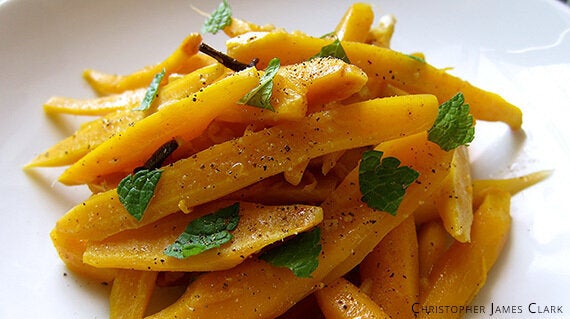
Like cinnamon sticks, star anise, and bay leaves, cloves are used to flavor dishes but aren't typically eaten whole. Cloves deserve better than this. When cooked, they become soft and flavourful. Why push them to edge of your plate? You can eat them whole. Not only do cloves have impressive nutritional and medicinal properties, they also add unique textures and intriguing visual embellishments to your culinary creations.
What the heck is a clove? Cloves are the aromatic flower buds of the evergreen clove tree, native to Indonesia and cultivated commercially in many African and Asian countries. Cloves have been used extensively in Ayurvedic medicine, traditional Chinese medicine, and western herbalism. Furthermore, modern nutritional science is increasingly recognizing cloves as a nutritional powerhouse.
Cloves and Diabetes
Diabetes affects 9.3 percent of the US population, or 29.1 million people, plus another 86 million who are prediabetic. The diabetes crisis is vast and seemingly insurmountable, but what if the humble clove could lend significant support? For a 2006 study, diabetes patients consumed 1 to 3 grams of cloves daily for 30 days. Serum glucose levels decreased significantly, from 225 to 150 mg/dL, and triglycerides decreased from 235 to 203 mg/dL. The researchers concluded that low-dose consumption of cloves decreases diabetes risk factors.
Cloves and Antioxidants
Gram for gram, cloves are the most potent dietary source of polyphenols. One-hundred grams of cloves contains over 15,000 mg of polyphenols. Compare this with blueberries, one of the most polyphenol-dense fruits, which have 560 mg per 100 grams. Of course it's not an entirely fair comparison because 100 grams of cloves might take months to consume, whereas 100 grams of blueberries can be consumed in one sitting.
One gram of cloves, or about 12-15 clove pieces, is a more realistic serving size. One gram contains 152 mg of polyphenols, or roughly the same amount contained in 100 grams of apple (136 mg), red onion (168 mg), or almonds (187 mg). So what's a polyphenol and why should you care? Polyphenols are organic plant compounds that behave as antioxidants and have many health-protective properties. Polyphenols are the most abundant form of antioxidants in human diets.
A brief high school chemistry recap may help illustrate the importance of antioxidants. An atom consists of a nucleus (which has protons and neutrons) and several orbiting electrons. Electrons occupy progressive layers, or shells, which surround the nucleus. Only two electrons can occupy the first shell. Any additional electrons must occupy the second shell, which holds a maximum of six electrons. Atoms with a full outer shell are stable and therefore are unlikely to interact chemically with other atoms. Atoms naturally seek maximum stability by gaining/losing electrons to fill/empty their outer shells, or by sharing electrons with other atoms.
When weak chemical bonds break, free radicals with odd, unpaired electrons are formed. Free radicals are inherently unstable and highly reactive. They can only become stable by "stealing" electrons from nearby stable molecules. When this happens, a) the original free radical becomes stable, and b) the formerly stable molecule becomes an unstable free radical. A debilitating chain reaction quickly ensues as the new free radical steals an electron from another nearby stable molecule, which then creates yet another new free radical. A single free radical has the potential to cause considerable damage.
To visualize this, imagine a single man entering a dance hall occupied only by couples. The single man breaks into one couple and steals the woman, thereby creating a) a new couple, and b) a new single man. The newly single man then breaks into another couple and steals that woman. This volatile pattern quickly spreads across the dance floor, causing confusion, resentment, and perhaps violence.
Whereas "free radicals" on the dance floor can inflame interpersonal relationships, free radicals within the body are among the primary factors contributing to chronic, systemic inflammation. Chronic, systemic inflammation affects blood vessel linings and many internal organs and systems, and is a primary marker for cardiovascular disease, stroke, and many other degenerative diseases. In a landmark 2003 scientific statement, the AHA and CDC concluded,
Basic science and epidemiological studies have developed an impressive case that atherogenesis is essentially an inflammatory response to a variety of risk factors and the consequences of this response lead to the development of acute coronary and cerebrovascular syndromes.
Free radicals also denature DNA strands, degrade fat cells by attacking the cell membranes, and damage protein cells by inactivating certain enzymes. Cancer, heart disease, acute respiratory distress syndrome, and rheumatoid arthritis are just some of the conditions caused by free radicals. Additionally, the free radical theory of aging (supported by many studies yet refuted by others) contends that aging is primarily caused, and accelerated, by free radical reactions.

How To Eat Cloves
Cloves, of course, come whole and powdered. To eat whole cloves, you simply need to soften them first by soaking or cooking them in water. Try soaking 10 to 20 cloves in a small amount of water and using this water, plus the softened cloves, to your next smoothie. Try adding whole cloves to any soup or stew. Or try my Iced Almond Milk Chai or my Orange Spiced Carrots, pictured above. Put a little clove in your life.
________
Christopher James Clark is the author of the critically acclaimed, award-winning book, Nutritional Grail: Ancestral Wisdom, Breakthrough Science, and the Dawning Nutritional Renaissance